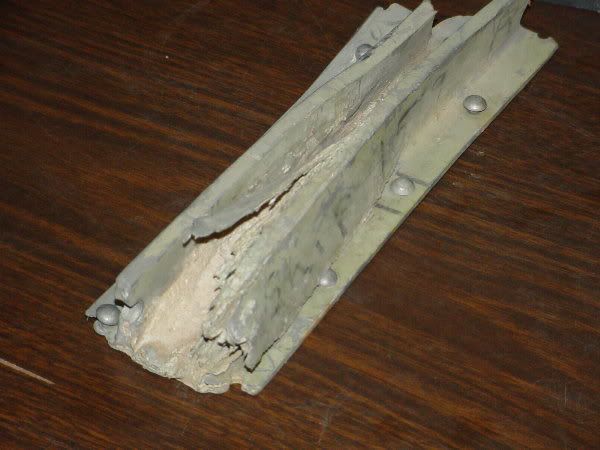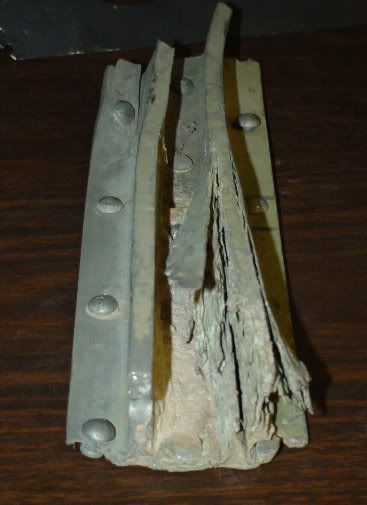Corrosion theory
Sat Sep 16, 2006 12:20 pm
I was asked on a previous thread, "what is the deal with all that corrosion," when talking about the B-29's FIFI and Fertile Mertyle. I can promise all of you that I'm just a dumb, greasy mechanic and don't even begin to know everything there is to know about corrosion and why it attacks our beloved Warbirds. However, I can tell you that (as most of you already know) I have been given a real quick cram course on this topic during the last couple of years while working on FIFI.
When we came across the really, really nasty stuff in the spars, ribs, stringers, and so on, we had all kinds of theories. B-29's built in Renton, WA didn't use primer during construction, or the salty air from years in Harlingen did it, or it's from years of touring and being forced to park outside in the elements. The list goes on. Many of these theories may certainly have had some serious contributions, but it was the old fella that owned the shop where our new stringers were fabricated that gave me the most likely theory.
He said that he had a contract to build these very same stringers during W.W.II and everything went well at first. But as time went on, circa 1944 and later, the smaller shops like his weren't given all of the proper materials to make the correct alloys. For example, he didn't have the coppers, zincs, and other materials to make an alloy to it's proper specs. He also said that the government was on their case about getting product out, so heat treating often times didn't take as long as it shoud have. His example to me was that the alloy 2024T3 (which I don't think actually existed then), was actually more like 2023T2 and a half. He said that he complained to the government agents in charge and they told him, "do you want this lucrative contract or not?" Obviously, he pressed on.
He made an additional point to me when he said, "I guarantee you that B-24A you have (built in 1940) doesn't have near the corrosion issues that your B-29 has (built in 1944)." He was right.
So, this is NOT to dispute any other theories on the development and growth of corrosion in these Warbirds, it is just another theory that anyone with aircraft built in late W.W.II might consider. It also depends on which foundry the metal for your aircraft came from.
So when you're doing inspections on your aircraft, kind of keep this thought in the back of your head, as there might be some strange chemistry going on in that otherwise "sturdy" mount. And trust me, this is some nasty stuff that grows from the inside out.
Hope this input is helpful.
Gary Austin
Crew Chief, B-29/B-24 Squadron
Commemorative Air Force
When we came across the really, really nasty stuff in the spars, ribs, stringers, and so on, we had all kinds of theories. B-29's built in Renton, WA didn't use primer during construction, or the salty air from years in Harlingen did it, or it's from years of touring and being forced to park outside in the elements. The list goes on. Many of these theories may certainly have had some serious contributions, but it was the old fella that owned the shop where our new stringers were fabricated that gave me the most likely theory.
He said that he had a contract to build these very same stringers during W.W.II and everything went well at first. But as time went on, circa 1944 and later, the smaller shops like his weren't given all of the proper materials to make the correct alloys. For example, he didn't have the coppers, zincs, and other materials to make an alloy to it's proper specs. He also said that the government was on their case about getting product out, so heat treating often times didn't take as long as it shoud have. His example to me was that the alloy 2024T3 (which I don't think actually existed then), was actually more like 2023T2 and a half. He said that he complained to the government agents in charge and they told him, "do you want this lucrative contract or not?" Obviously, he pressed on.
He made an additional point to me when he said, "I guarantee you that B-24A you have (built in 1940) doesn't have near the corrosion issues that your B-29 has (built in 1944)." He was right.
So, this is NOT to dispute any other theories on the development and growth of corrosion in these Warbirds, it is just another theory that anyone with aircraft built in late W.W.II might consider. It also depends on which foundry the metal for your aircraft came from.
So when you're doing inspections on your aircraft, kind of keep this thought in the back of your head, as there might be some strange chemistry going on in that otherwise "sturdy" mount. And trust me, this is some nasty stuff that grows from the inside out.
Hope this input is helpful.
Gary Austin
Crew Chief, B-29/B-24 Squadron
Commemorative Air Force
Sat Sep 16, 2006 2:00 pm
Pretty interesting perspective. Thanks.
Sat Sep 16, 2006 8:03 pm
Hey Gary,
How's this for corrosion!


That's a chunk of B-29 spar or wing rib. Can't say definitively as they kept making changes to the wing during production, and the only detailed interior photos I have are of early production wings (XB-29, to be exact!). But I'm betting wing rib, what do you think?
That peice came out of Pyote from one of the scrapped -29's, and it layed in the field there until the 70's. No idea when that corrosion started, but it's pretty nasty nonetheless!
Trevor
How's this for corrosion!


That's a chunk of B-29 spar or wing rib. Can't say definitively as they kept making changes to the wing during production, and the only detailed interior photos I have are of early production wings (XB-29, to be exact!). But I'm betting wing rib, what do you think?
That peice came out of Pyote from one of the scrapped -29's, and it layed in the field there until the 70's. No idea when that corrosion started, but it's pretty nasty nonetheless!
Trevor
Sun Sep 17, 2006 12:46 am
What is now 2024 was called 24ST.
Improper heat treatment does cause intergranular corrosion to develop. This is a well known fact.
Improper heat treatment does cause intergranular corrosion to develop. This is a well known fact.
Sun Sep 17, 2006 6:26 am
Thats not bad. It should "buff" right out... 
Sun Sep 17, 2006 7:32 am
B29Gunner wrote:Hey Gary,
How's this for corrosion!
That's a chunk of B-29 spar or wing rib. Can't say definitively as they kept making changes to the wing during production, and the only detailed interior photos I have are of early production wings (XB-29, to be exact!). But I'm betting wing rib, what do you think?
Trevor
Actually, there are four primary stringer extrusions used on the B-29 (the B-29A, like FIFI anyway). The piece you have looks to me like the type that's primarily used in the cockpit section. They are also used throughout the rest of the fuselage, but mostly in the cockpit from what we've seen.
With the exception of the spars, the components in the wing are quite thin (they start at .020" and go to .040"). Darn near scary lookin' if you were to just see one rib at a time. But they make up for it with quanity and doubling them up. For example, there are 44 ribs just on the aft portion of the rear spar. I know this because we had Odegaard Wings fabricate them for us to install on our left, outer wing panel last year.
Gary
Mon Sep 18, 2006 7:58 am
Very interesting photos.
Mon Sep 18, 2006 5:08 pm
APG85 wrote:Thats not bad. It should "buff" right out...
I read right here on the internet you can put bondo in the crack and she'll fly again.
???
Mon Sep 18, 2006 5:29 pm
you can put bondo in the crack and she'll fly again.
you guys are sounding like Havard IV. Stop it!!!
Mon Sep 18, 2006 5:50 pm
Gary,
What does the SRM say about what that the material is supposed to be ? I'll wager it is something close to a 7000 series aluminum. While it has been my experiance that the 2000 series aluminum's do corrode, they do not, as a general rule exfoliate near as bad as the photo shows. While the 7000 series alloys will do exactly that as it shows in the photo.
However, you make good points about when the alloys were made and perhaps not having the "right stuff" to make the PROPER alloy's during the war years.
I say all of this in respect that Boeing sure does love their stronger alloys. In that they trade off longevity for strength over the airframe's lifespan.
Just my two cents.
Paul
What does the SRM say about what that the material is supposed to be ? I'll wager it is something close to a 7000 series aluminum. While it has been my experiance that the 2000 series aluminum's do corrode, they do not, as a general rule exfoliate near as bad as the photo shows. While the 7000 series alloys will do exactly that as it shows in the photo.
However, you make good points about when the alloys were made and perhaps not having the "right stuff" to make the PROPER alloy's during the war years.
I say all of this in respect that Boeing sure does love their stronger alloys. In that they trade off longevity for strength over the airframe's lifespan.
Just my two cents.
Paul
Corrosion
Wed Sep 20, 2006 1:27 am
I don't think Boeing cared to much about corrosion because they mostly built planes for the military and they thought there planes wouldn't be around in 10 years one way or another.
Aren't most of the B-17's still flying actually made by Douglas who cared more about corrosion like EAA's Aluminum Overcast?
Aren't most of the B-17's still flying actually made by Douglas who cared more about corrosion like EAA's Aluminum Overcast?
Wed Sep 20, 2006 9:38 am
I've seen B-757 7075-T6 Floor beams and seat track under the sugar gone! These beams were about big as your fist! The pits were real bad. All of the nasty stuff spilled upstairs went to the bilge. Plus somtimes you could tell they have been hauling fish from Alaska.....
Wed Sep 20, 2006 9:43 am
I don't know about who cared more about corrosion...none of these airplanes were built to fly for 60 years...
I think only Sentimental Journey is Boeing built...everything eles seems to be either Douglas or Lockheed built.
I think only Sentimental Journey is Boeing built...everything eles seems to be either Douglas or Lockheed built.
Wed Sep 20, 2006 9:49 am
The B-17 Sentimental Journey is a Douglas built B-17G-85-DL, but the B-29 Sentimental journey is Boeing built.
Considering what B-17 Sentimenal Journey did in it's past, there was very little corrosion on her when I worked on it.
Considering what B-17 Sentimenal Journey did in it's past, there was very little corrosion on her when I worked on it.
Wed Sep 20, 2006 11:17 am
I wonder if the FAA reads this message board? Something to think about before making broad sweeping, damming statements on an open forum...
John
John